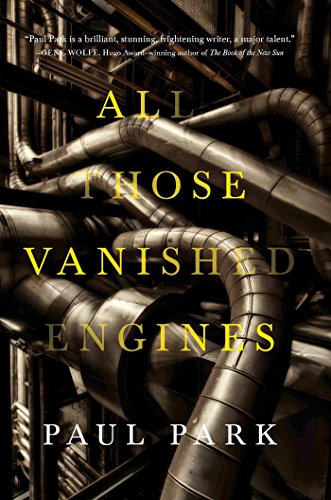
![]() All Those Vanished Engines by Paul Park
All Those Vanished Engines by Paul Park
I’m not a big reader of avant-garde fiction. In fact, I’m SO not a big reader of it that I’m not even sure if I’m applying the term correctly to Paul Park‘s recent novel All Those Vanished Engines. I’m probably not. But the thing is, I’m not sure what term to apply to it: meta-fiction? Experimental fiction? Alternate history with several unreliable narrators who may or may not be Paul Park himself?
All Those Vanished Engines is a novel told in three parts. The first part is about a child, Paulina, who lives in Virginia after the Civil War in an alternate history in which the States aren’t so United anymore. The conflict continues, with the Queen of the North brokering an uneasy truce with the South. Paulina, forbidden to read, has begun to write a story about a boy named Matthew who lives in the future. Her story, called “The Bracelet,” is told in italics and features phonetic spelling. The only thing is, her character Matthew begins to tell a story of his own, about a girl named Paulina from the past. Details of the two worlds begin to bleed into each other — a woman with a mole on her nose, a bracelet, a battle — until it is unclear which is the story and which is the story within a story.
The second part is told from Park’s perspective and features interviews with nursing home residents. The first one, an engineer, talks about intensely powerful engines of sound that he helped to create, and the giant flowers that sprang from the run-off, so large they couldn’t be pollinated by normal insects. “Snapdragons as big as a man’s fist… blossoms that used to pop when they opened… one night I saw a moth with a ten-inch wingspan.” At some point the narrator leaves him, and meets a girl. She rambles on and on about his dead mother. “Your mother — we thought she was so very strange, with those sandals, and long skirts, and her endless array of handmade necklaces from — you know — Afghanistan or Pakistan…” The narrator’s attention wanders as he watches a plane flying overhead. At this point I wondered, “Well, if he’s not even listening to her, why do I have to?”
I didn’t make it to the third part.
Park certainly knows what he’s doing in All Those Vanished Engines. The novel’s lack of meaning was not an accident. At one point, Paulina describes watching men tear apart a termite-infested beam, asking “Where was the queen in all that whirling debris?” Park wants us to contemplate the termite nest that is his novel in all its glorious twisting reflexivity. In the second part, the blind engineer describes layering sound upon sound in an explosive chaos of noise, and the Park-narrator character asks, “Could you make stories, text, actual words, the way the blind engineer had manufactured sound?” This novel is Park’s attempt to do so and, like a good red wine, it is bold and complex.
I think my problem with All Those Vanished Engines was that there was no center of gravity. I wanted to like it, but everything was oblique and shifting — character, perspective, plot, topic — and I couldn’t find anything to latch onto. It reminded me at times of Woolf‘s The Waves, of Calvino’s If On A Winter’s Night A Traveler, and of VanderMeer‘s Authority. But the difference is that, while each of those books is experimental in one way, they are not experimental in all aspects. Woolf plays with shifting perspective and stream-of-consciousness writing, but the topics she covers are mundane details of average people’s lives — their relationships with schoolmates and lovers, their careers and families. Calvino goes meta, a book within a book within a book ad infinitum, but each of the mini narratives is told from a single perspective and the overarching narrative follows a discernible (if intentionally ridiculous) plot. VanderMeer uses relatively straightforward narrative techniques to reveal and conceal his topic, a horrific mystery that always eludes us, that can’t be defined.
I felt like, with All Those Vanished Engines, Park was trying to use all of these techniques, and it ended up being too much noise.



Yeah, that sounds too complex for me. Thanks for the warning.
I had to force myself to finish this book, and I’m still not glad that I did. I didn’t like anything about it, truth be told.
I loved the first two books of his Romanian quartet, but ran around of steam two-thirds of the way through Book Three.
Marion, are they similar to this book, or are they a more cohesive read? The title sounds great, to me, but this book has put me off him in a big way.
I’ve only read the first one, but it’s nowhere near as confusing or abstract as this sounds. There’s some alternate-history stuff–I’ve heard it compared to The Golden Compass–but nothing that was confusing.
Has anyone ever read Paul Park’s Starbridge Chronicles (1987-1991)? I have the three books in Avon paperback with amazing artwork by Gary Ruddell, which always intrigued me. This series never gained a following but got a lot of praise when it first appeared.
https://www.blackgate.com/2015/04/12/vintage-treasures-the-starbridge-chronicles-by-paul-park/